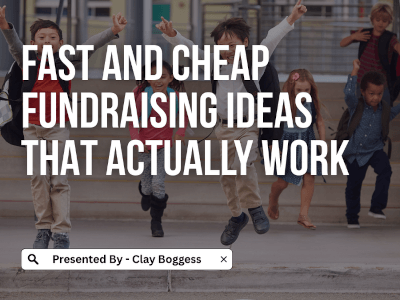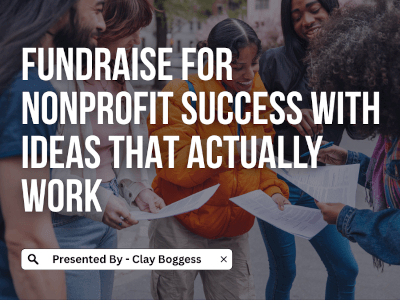
How to craft the ultimate pitch for your fundraising product.
Fundraising programs for your school are, on a practical level, highly effective ways to close critical funding gaps and ensure your school has the resources it needs for your child to be successful in their education. In addition to quality products and effective prize programs, one of the critical elements of a successful product fundraiser is the big pitch.
Since many product fundraisers rely on person-to-person selling, this often means that students are the ones making the all-important ask. At Big Fundraising Ideas, we know this is a critical moment in the fundraising process, so we've put together a guide with five great tips to help prepare your students to be successful in their money raising efforts.
Together, we'll walk through the basics of crafting a compelling sales pitch to help your students develop strong public speaking, sales, and persuasive skills while meeting big goals to earn industry-leading rewards.
In his acclaimed book, To Sell is Human, Daniel Pink makes a critical observation to guide our fundraising pitch: "To sell well is to convince someone else to part with resources—not to deprive that person, but to leave him better off in the end."
When your fundraiser is product-based, you can offer something in exchange rather than relying on the even more difficult sale of pure philanthropy. Sure, your customer base—friends, family, neighbors, and coworkers—will give up a small sum of cash. Still, if you sell well, the product they get in return and the intangible benefit of helping their community succeed will seem like an absolute bargain.
With the idea of "leaving him better off in the end" in mind, consider these five tips to guide your school fundraising efforts and the creation of your personal sales pitch:
- Be mission-minded: sell the what and the why.
- Learn your product.
- Practice your pitch.
- Monitor the pressure.
- Serve the customer.
School Fundraising Pitches Should Be Mission-Minded
Fundraising for your school isn't just a gratuitous act; more than likely, your school is trying to meet real needs that will make a real difference in the quality of life. With teachers getting less and less of a budget for school supplies—some as little as $1.60 per student, according to a Time Magazine report—fundraisers may mean the difference between barely getting by and thriving in the classroom.
When sitting down with your child or student to draft a fundraising product sales pitch, explicitly include what your elementary, middle, or high school is trying to accomplish with the funds raised. Consider the following examples:
- "My school is trying to raise money for five new computers for our media center."
- "My school didn't get enough money this year to cover experiential learning, and research shows this is critical to student success."
- "Our classrooms have outdated textbooks, many of which are falling apart. We want to buy a new class set to all have the same learning opportunity."
- "The neighborhood high school can't subsidize the extracurricular sports or arts program as it has in the past. Without this fundraiser, students might not have those programs, hindering their academic success and future opportunities."
The "need" forms the basis of your mission. In a previous article, we shared why the mission should be the fuel for your communication strategy, which includes the all-important in-person sales pitch:
When your fundraising strategy has a product at the core of its operation, you must connect this product to the excellent work being done due to its sales to retain donors annually and fight the attrition in exhausting and inefficient fundraising programs.
There's no doubt they'll love the pretzels, cookies, and flowers you're selling them, but what they need to love to feel good about their purchase is the difference it's making. You can accomplish this by framing your fundraiser with a vital mission.
In short, don't lag or shortchange your mission. It accomplishes what Pink suggests by showing the customer how they, and their community, will be better off if they buy what you're selling. Once you've covered the platitudes (Hi, Ms. Greene, how are you? etc.), get suitable to your mission. It's the hook that will put people in the right frame of mind for you to share about your product and receive this information in a way that is more likely to turn a lead into a sale.
School Fundraising Pitches Should Show a Love for Product

At Big Fundraising Ideas, we're passionate about the product. From a candy bar fundraiser to wrapping paper to flowers, we provide school groups with quality fundraising ideas to help them meet their goals.
When your school selects a product, they're giving students and other sellers a significant advantage in the fundraising marketplace by providing an opportunity to learn and love this money-making tool. When preparing for your sales pitch, it's essential that you, too, develop a personal love of the product you're selling.
Start by reading the information provided by your school fundraising committee, such as the Parent Teacher Organization (PTO). If you can, research your own and read online reviews to find out what customers who have purchased a particular product brand have especially enjoyed about it.
Geoffrey James, a contributing editor at Inc.com, suggests, "The most successful entrepreneurs never "sell" as a separate activity, and neither do the most successful salespeople. Whether their passion is to change the world or just help people one by one, it's that passion that does the "selling."
While your mission fuels a significant part of this passion, so does your product or idea. If, for example, you're choosing a popcorn fundraiser, tell your customers how you're excited to get your own because your family always makes popcorn a feature of your family movie nights. Share with them how it's guaranteed to be a fresh and flavorful snack or an excellent treat for the kids. Popcorn isn't just a salty (or sweet!) treat but a way to unite people.
After reading that, popcorn probably makes you feel a little more empowered. A vital mission followed by a personalized message accentuating all the great benefits the customer will receive by buying your fundraising idea is a one-two punch in the sales world.
School Fundraising Pitches Should be Practiced
Any public speaking expert will tell you that practice is the key to becoming an effective public speaker. By practicing, you'll gain tremendous confidence in the field, which will translate positively to your customers, who will feel that you know and believe in your product.
Forbes contributor T.J. Walker, who coaches professional speakers for a living, outlines the best way to practice for optimal results:
Over and over again, clients ask, “TJ, do I really have to watch myself? I hate watching myself on video!” Sorry, but you do. The same way you have to read a letter before you send it or look at yourself in the mirror at least once before you leave for work in the morning. Is it painful to watch yourself? Yes. But this is less painful than wasting the time of people you are speaking to because you were boring or hard to follow. So grab a video camera, a cell phone with video capture, a Webcam, or any other video device and record your speech. Then watch it.
His analogy is perfect—we seek feedback on anything we want to improve, often being our own harshest critic in the process. Consider this: won't you have the most confidence and be able to deliver the strongest pitch if you've seen it yourself and worked through the rough spots?
In addition to increasing your self-confidence in your pitch, practicing will help you maintain brevity. Ideally, the selling situation will be a natural and comfortable conversation. Still, it's your job to deliver that initial two to three minutes of high-impact pitching, and that's the powerful piece you should internalize before hitting the neighborhood to sell your fundraising product. And, speaking of a time frame, U.S. News offers some great tips on short and punchy "elevator pitch" writing that can take your selling conversation to the next level.
School Fundraising Sales Pitches Should Monitor the Pressure
Everyone who has ever picked up the phone only to be greeted by a solicitor knows the discomfort of engaging with a high-pressure salesperson. This is true even when we need the product they're selling.
Sales pressure is experienced when consumers feel they are being cornered or coerced to make a purchase they're not ready and willing to make. Typically, because product fundraisers for schools are time-bound, you will only have one shot with each customer, so it's essential to look for cues that might mean a customer doesn't want to commit right away.
The following cues might indicate that a customer is not ready to purchase a product to support your school fundraiser whenever you show up and their doorstep:
- Requests to leave a brochure or information about your product(s).
- Distracted, hurried, or dynamic body language (doing other things while you're sharing).
- Delaying or avoidant language. (I'll have to check with my spouse first.”)
- Explicit denials of interest. ("I can't this year.)
Rest assured that, except for the last cue, none of these necessarily mean the customer won't participate in helping you raise money for your school. Instead, they probably want time to consider how they can best help support you and purchase a product they feel good about.
If you encounter one of these cues, the best response is to offer to leave some information and then arrange to follow up in person or by phone later. Be sure to set a date within the parameters of your fundraiser, and give them the means to contact you should they have any questions. Money is hard-earned, and people want to ensure it's well-spent even for something as good-natured as a school fundraiser. Remember Daniel Pink's advice: you want to leave them feeling better.
School Fundraising Pitches Should Serve the Customer
Think about your best service experience at a restaurant or hotel. What was it that made this experience so great? Did their interaction feel genuine and authentic? Did they make you feel like your needs were the most important?
The best sales experiences are quality customer service experiences. From working around a potential buyer's schedule and delivering their goods promptly to keeping them informed about what their purchase is helping your school do, you can ensure that your friends and neighbors feel like they've done more than buy a great product; you can make them feel like they've had a great experience.
In everything you set out to do, ask yourself, "Is this in the best interest of the customers who will help my school reach its goal?"
With that mindset, you'll be on a path to fundraising success. If you're interested in learning more about great fundraising products or want to do your research in planning the perfect school fundraiser, check out our school fundraising ideas and products!
Author Bio
Clay Boggess has been designing fundraising programs for schools and various nonprofit organizations throughout the US since 1999. He’s helped administrators, teachers, and outside support entities such as PTAs and PTOs raise millions of dollars. Clay is an owner and partner at Big Fundraising Ideas.



